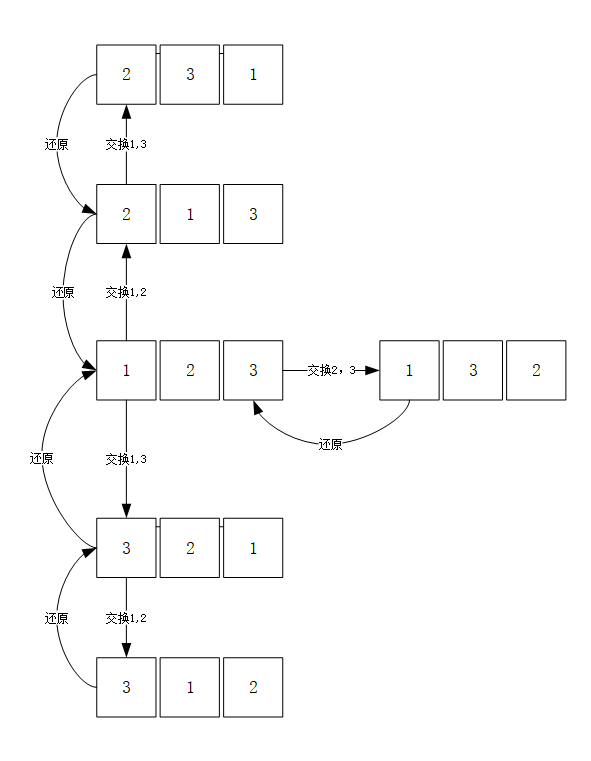算法设计:全排列算法代码实现
在上星期的算法设计课程的学习中,我们学习了两种全排列算法,该算法用于求出数组{1,2,3,...,n}的所有可能的排列,今天我们就来看看这个算法的具体代码实现。
1. 第一种算法
第一种算法和我们现实生活中习惯的方法较为相似,以{1,2,3}为例,我们先写出第一种排列123,然后将2与3交换,得到132;再回到123,交换1与2得到213,再将1与3交换.....直到得到所有的排列。

该算法伪码如下:
PERMUTATIONS1(int n):
- for j←1 to n
- a[j]←j
- end for
- perm1(1)
perm1(int m):
- if m = n then output a[1...n]
- else
- for j←m to n
- 互换a[j]和a[m]
- perm1(m+1)
- 互换a[j]和a[m]
- end for
- end if
具体代码实现如下:
1 //第一种排列生成算法 2 public class Permutations1 { 3 private int a[] = new int[50]; //声明存放数据的数组 4 private int length = 0; 5 //构造函数 6 public Permutations1(int length) 7 { 8 this.length = length; 9 for(int i=1;i<=length;i++) 10 a[i] = i; 11 } 12 13 //执行全排列算法 14 public void perm1(int n) 15 { 16 if(n == length) 17 this.dispArray(); //到最底层时输出排列结果 18 else 19 { 20 for(int i=n;i<=length;i++) 21 { 22 this.swap(i, n); //交换两数的值 23 perm1(n + 1); //递归执行perm1 24 this.swap(i, n); //恢复位置 25 } 26 } 27 } 28 29 //交换数组中两数的值 30 public void swap(int x, int y) 31 { 32 int t = a[x]; 33 a[x] = a[y]; 34 a[y] = t; 35 } 36 37 //输出排列 38 public void dispArray() 39 { 40 for(int i=1;i<=length;i++) 41 System.out.print(a[i]); 42 System.out.println(); 43 } 44 }
2. 第二种算法
第二种算法比较类似于我们中学学的排列组合,还是以{1,2,3}为例,我们先确定第一个位置的数字3,再确定第二个位置的数字2,再确定最后一个位置的数字1,然后我们再向前恢复,再次确定第二个位置的数字....直到得到所有的排列。

该算法伪码如下:
PERMUTATIONS2(int n):
- for j←1 to n
- a[j]←0
- end for
- perm2(n)
perm2(int m):
- if m=0 then output a[1...n]
- else
- for j←1 to n
- if a[j]=0 then
- a[j]←m
- perm2(m-1)
- a[j]←0
- end if
- end for
- end if
具体代码如下:
1 //第二种排列生成算法 2 public class Permutations2 { 3 private int a[] = new int[50]; //声明存放数据的数组 4 private int length = 0; //声明数组长度 5 6 //构造函数 7 public Permutations2(int length) 8 { 9 this.length = length; 10 for(int i = 1;i<=length;i++) 11 a[i] = 0; //将所有元素记为零 12 } 13 14 public void perm2(int n) 15 { 16 if(n == 0) 17 this.dispArray(); 18 else 19 { 20 for(int i=1;i<=length;i++) 21 { 22 if(a[i] == 0) //如果该位为空 23 { 24 a[i] = n; //将n的值赋给该位 25 perm2(n - 1); //递归执行 26 a[i] = 0; //恢复 27 } 28 } 29 } 30 } 31 32 //输出排列 33 public void dispArray() 34 { 35 for(int i=1;i<=length;i++) 36 System.out.print(a[i]); 37 System.out.println(); 38 } 39 }




 浙公网安备 33010602011771号
浙公网安备 33010602011771号